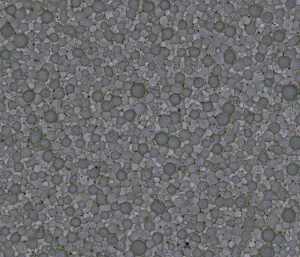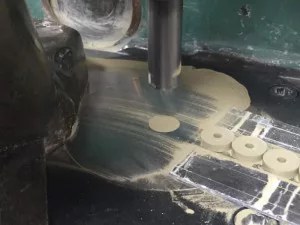Starting with high quality PZT powders makes pressing a little easier.
Brian Julius, V.P. Manufacturing / Materials Engineer
Ron Staut, V.P. Technology
All ceramic parts begin as a powder in one form or another. How that powder is transformed into a starting shape, however, can differ. It is the compaction through pressing of that powder into partially dense (~60% dense) “green” bodies that makes the manufacture of bulk PZT ceramics possible.

When pressing powders, it is important to understand and consider the critical aspects of the process. The control and consistency of the powders, the die design, and the various pressing technologies we have available to us today all play critical roles when pressing powders into shapes. The required pressing force, the pressing speed, the volume of the component, and the number and value of the components being pressed all play a role when choosing a pressing technology. Some common press technologies are wet or dry bag isostatic, single action uniaxial, dual action uniaxial, and rotary uniaxial. Uniaxial pressing, either single or dual action, can be hydraulic or mechanical and is the most common form of pressing in this industry due to its flexibility, short cycle time, control over press rate, and its cost effectiveness for pressing long runs of product.
When preparing for pressing, it is important to understand the potential failure modes so they can be addressed when necessary. The single most critical control when pressing is control of the powder. As discussed in previous articles, the starting powder for this process is pre-reacted, spray dried PZT powder in the form of binder containing hollow spheres in the range of 50-150um (Figure 1 – APC 850 Powder, notice the consistent spherical shape and size). We can consider the effects of the powder properties as we break down the pressing cycle.
The component being pressed is only as good as the die inside which it is formed. When designing press tooling, it is important to consider the entire pressing and firing process to take into account the change in the volume of the part due to densification resulting from sintering. (Figure 2 – A green pressed ceramic ring (left) of approximately 4.75 g/cc alongside the same ring after sintering (right) to approximately 7.8 g/cc. Notice the change in size pre an post sintering.)

With those things considered, a die slightly larger (15-20%) than the desired finished component size can be produced (Figure 3 – Typical ring shape punch and die set for one of our stokes R4 dual action uniaxial powder compacting presses.)

For ease of ejecting the pressed component from the die, a taper can be machined into the die bore typically not exceeding .001″ diameter change per 1.000″ of bore length, which also helps reduce die wear. For standard geometries (disk/ring) a small chamfer can be designed into the punch faces to reduce component chipping when ejecting. Die/punch clearance to allow for alignment and air escapement is also critical and can vary based on design from around .002″ to .005″.
The die fill is a very important control since the weight of powder in the die will determine the weight of the pressed component. This means the pressed component weight, density, and volume are all directly related to the die fill. The result? It is critically important to consistently fill the die for each press cycle. With runs of pressed product in the thousands or hundreds of thousands of pieces, each and every die fill must be uniform and consistent. The morphology of the powder plays a large role in consistent die fill. Consistent spherical particles of a narrow particle size distribution (50-150 um) will flow easily into the die while broken spheres, angular particles, toroidal shapes or clusters of smaller particles will not flow easily. If problems are encountered, it may be useful to blend or gently mix (tumble) the starting powder to reduce variability. For spray dried PZT, a typical compaction ratio to reach desired green density is 2:1, therefore the die fill depth should be approximately twice the pressed component thickness. (Figure 4 – Completed die fill stroke, the upper punch is moving in for compaction).


Once the die is uniformly and consistently filled, the press stroke begins. Approximately 10,000 PSI is required to achieve the 2:1 compaction and ~4.9 g/cc desired green density (PZT has a theoretical density of ~8g/cc). As the compaction occurs, the loosely packed hollow spherical particles are crushed into a more closely packed configuration of primarily crystallites. Two things are critical at this stage, air escapement and friction. As the hollow spheres collapse, the air within them as well as in between them must evacuate the die cavity, and this escapement can be maximized by proper die/punch clearance, press speed (slowing the press can allow air to slowly escape), and the strength of the hollow spray dried spheres (circling back to controlling the powder in powder manufacturing). Stronger spheres support open pathways for air to escape further through the compaction stroke. Weak spheres will crush immediately and block potential pathways for air. If the air inside the die cavity cannot escape, it will become entrapped in the component, it will compress during the compaction cycle, and it will form its own pathway, a crack defect. Any defect in the pressing stage will carry through to the finished component, so it is critical to have air escapement under control when pressing.
While the compaction stroke is occurring, there is lot of motion going on in the die cavity. Particles are moving against other particles, against die walls, and even against the punch faces. The result is friction and drag, which generates density gradients and unnecessary forces within the component. To reduce these friction forces, a lubricant may be added to the powder prior to pressing. Wax like stearates are among the most commonly used lubricants for dry pressing, since small additions can reduce ejection force by 50% or more. At the end of the compaction stroke, some press styles will allow the holding of some force on the component while it ejected. Depending on the size or shape of the pressed component, this may be a necessary technique. Other presses do not allow this, and the compaction (upper) punch retracts from the die in preparation for the ejection stroke.


At this stage, there is typically a finished, fully compacted component waiting to emerge from deep in the die cavity (Figure 5 – with the upper punch retracted after compaction, the pressed component can be seen deep in the die cavity waiting for ejection). The ejection (lower) punch forces the component up through the die cavity where it emerges to the die table and can be removed from the press for further processing. Reducing the force required to eject the component is critical. Any drag present between the component and the die wall during ejection can generate tensile stresses in the component, causing cracking during ejection. Again, stearates or other lubricants can be added to minimize die wall friction and reduce force required for ejection. As the component emerges from the top of the die, there is some tendency for it to rebound to a slightly larger size. This can also result in tensile forces and cracking during ejection, but this also can be mitigated. First, the .001″/1.000″ die cavity taper allows the part to gradually, gracefully rebound slightly. Second, again circling back to control of the powder, the binder system can play a very important role in these phenomena.

While the binder system is formulated to help actually bind the component together, it also must act as a plasticizer giving the component some degree of flexibility and reducing its brittleness. While PVA (poly-vinyl alcohol) binder systems are typically used, a PEG (poly-ethylene glycol) component is often added at a 60:40 ratio PVA:PEG respectively to help with the plasticity of the component and thereby reducing the likelihood of defect generation as a result of component rebound during ejection.
After ejection, die fill can occur, starting the process again. The single press cycle can range from fractions of a second to minutes, depending on the press technology being used, the geometry and complexity of the component, and the quality of the powder. Average rates for uniaxial presses are in the range of 10-20 parts per minute.
Once the component is removed from the press, it can be staged on ceramic setters and prepared for multiple firing stages.
Keep and eye out for the next month’s article, the next in the Manufacturing Series, Removing Organic Binders and Sintering PZT.
Happy Pressing!